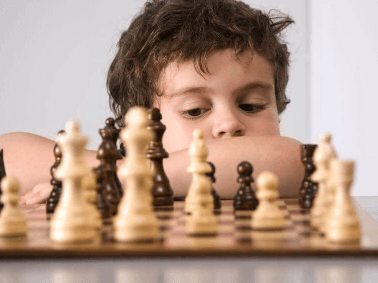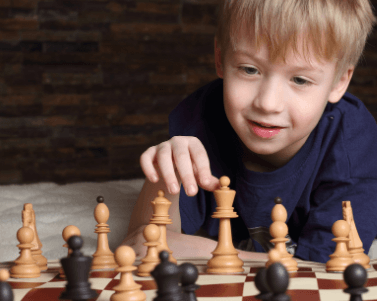Teaching Chess to a 4-year-old kid is an incredible way to learn! Infants acquire various skills and abilities during the first few years of life.
Not only can they learn multiple languages, but they can also learn a variety of physical abilities, such as walking, jumping, and climbing. Also, all kids love to play. They start playing simple board games from a very young age.
Why should you teach Chess to a 4-year-old kid?

Kids can learn Chess early, even as early as two years old! The key is to teach in a child-centered way rather than relying on standard methods for adult learners or school children.
Chess for kids is not a myth created by parents. It’s a great opportunity to raise children socially and academically while having fun together!
How to Teach Chess to 4-Year-Old Kid?
Chess is a very complex game with billions of possibilities and many rules. So, don’t overburden your 4-year-old children using the information in bulk. Teach children at an appropriate pace.

Because this rate varies from child to child, educators should notice subtle signs that the child is ready to continue to the next subject.
1. Buy a simple Chess set
Also, choose the right Chess set for your child. Buying an expensive wooden chess set is nonsense when your child starts investigating the beautiful shape of each piece.
Buy a set of large pieces of sturdy plastic and let your child discover all the nuances of sculpting the board.
It’s also important to explain how all six pieces move in a few minutes without putting them all into the hands of a small child.
Unfortunately, so many kids have taught it, which may be why some lose interest so quickly! There are too many for the youngest kids to grasp in one place.
2. Start with Luke
Many people start their chess classes by teaching them horse movement. It seems logical at the time, but it’s often not the perfect place to start from scratch, and it turns out to be a mistake.
Because pawns are one of the most complex pieces! Therefore, it should be taught at the end. Luke’s movements are the easiest to grasp.
You can apply many baby steps when analyzing every move in your piece. Learning these skills using a piece on the blackboard is much easier. So, don’t overburden the children;; take them one step at a time!
3. Start with a simplified version of the chess rules
Don’t try to learn all the rules at once. It’s much more fun to start the game with simplified chess rules. Once you become familiar with the simplified rules, you can gradually add others until you eventually play with all the standard Chess rules. Standard Chess is a game of Chess uses all the rules determined by the World Chess Federation (FIDE).
4. Make it fun
Kids who like something are much more likely to get involved! A child’s desire to play and have fun is healthy, and a love of fun can encourage children to play Chess more often.
5. Don’t stick to the rules
Sometimes we forget that the purpose of having rules in a game is to make the game fun. The rules are intended to clarify what can and cannot be done to provide the game with an appropriate level of challenge, maintain interest, and maintain fairness between players. The rules should make the game enjoyable.
However, when a child learns Chess for the first time, certain chess rules can make Chess seem too difficult, complicated, or limiting. If a rule gets in the way of fun, throw it away until it makes sense to add it back later.
For example, if a learning child wants to make all the pieces move like a horse, undo a move he has made, or change direction in the middle of a game.
The point is to keep you engaged in learning by keeping it fun. If a particular rule is preventing that from happening at the moment, defer that rule until later.
6. Enjoy the pieces and board
When the four years older son sees a chess set, he often picks up the horses and starts playing with them like action figures in epic battles. The board becomes the battlefield, and you hear something like Attack or Defend the King in an excited voice. He grabs a few pieces and makes them fight in the air, then either or both are wounded in battle.
By doing this, he is playing Chess. Sure, it’s a complete disregard for the rules and maybe a little more violent than I’d like to see him get involved, but it’s also his natural, cool way to enjoy the chessboard and horses.
Chess sets are good to watch and play with. The board has contrasting squares and a clean, organized design. The different pieces each look attractive and stimulate the imagination. Part of playing Chess is admiring the board and the horses. This can mean putting kids on a dressing table to play with or looking at them like action figures.
7. Play at your level
This is intuitive for most parents, but it is worth recalling why it is such an important part of teaching children to play Chess. Playing at the child level is a way to meet at a developmental stage so children can learn more effectively. This sometimes means reaching out easily to kids, giving them an idea of what’s a good move and not, and allowing them to experience success by catching pieces and winning games.
This doesn’t necessarily mean letting them win all the time. That would mean playing below their level. After all, making mistakes is a great way to learn. When learning something for the first time, remember that it helps to experience some initial victories to give you confidence that you can learn to do it well.
8. No need for memorization by using visuals as reminders
For many beginners, remembering how each piece moves is the hardest part of learning Chess. A great and easy way to solve this problem is to keep a reference sheet handy as a reminder of how each piece moves. You can buy a Chess set with a visual reference or make it your own.
If you’re making your own, don’t forget to use images whenever possible as a visual representation of how a piece move is easier to understand than just looking at words.
9. Let your child set the speed
Children will experience the most long-term benefits when learning Chess if they can learn at a pace that suits their age, learning style, and level of interest. This means observing your child to see which pace works best for them and asking if they want]to learn more or to play by the rules they already know.
10. Give them a chance to play Chess often
You may find that your child wants to play Chess more often than you or your siblings would like. If so, that’s great! You can boost your interest in Chess by giving you plenty of opportunities to play with others.
Conclusion – How to Teach Chess to 4-Year-Old Kid?
Finally, your four years old kids can learn Chess before school at an age where they can master dozens! The key to success in teaching Chess to children is a lot of patience and a very child-centered approach, which identifies the child’s strengths and special needs.
FAQs
Which Chess should I use for a four years old kid in 2023?
Use a beginner Chess set like Fun Family Chess: Some chess sets are made with chess learning in mind! Fun Family Chess is a chess set designed to make learning chess fun and easy for kids and adults. It includes a complete wooden chess set, instructions, and some reference cards for a simplified version of Chess, so no memorization is required.


